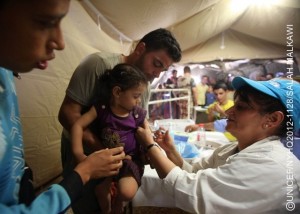Help one million refugee children in Syria Crisis
2013-08-23
 With Syria’s war well into its third year, the one millionth refugee child appeared today, signifying a million of Syrian children have been forced to flee their homeland as refugees.
With Syria’s war well into its third year, the one millionth refugee child appeared today, signifying a million of Syrian children have been forced to flee their homeland as refugees.After the outeak of Syrian civil war, 5 million people are affected and 1.88 million of them are forced to become refugees, in which half are children. Latest figures show that more than 740,000 Syrian child refugees are even under the age of 11.
This year alone, UNICEF has provided nearly 167,000 children with psychosocial assistance and more than 118,000 children with education, ensuring their rights to education are not deprived by the conflict.
The crisis is not yet over. Watch Aya's story - A real story in a million:
Aya (Left), an 8 years-old cheerful girl, fled from Syria to Lebanon two years ago.
Coming to an unfamiliar territory, the family of nine lived in a narrow temporary shelter. Although they received monthly food stamps, the food amount could only meet the demand for more than half month.
When Aya’s elder other and sister worked in fields, earning HK$31.2 a day (US$4), she had to take care of her 11-year-old elder sister, Libaba, who suffered from Down's syndrome. Aya taught her elder sister how to bath, wear clothes and eat, showing great care over her. They became the best friend of each other.
Although Aya’s elder others and sisters got opportunities to receive education, Aya was out of school because of wars. The family could not afford the transportation fee of Aya to school as well. Therefore, studious Aya would ask questions when her sisters came back from school. Aya hoped to be a paediatrician in the future and to cure poor children at no charge.
UNICEF supports local NGO partners in providing psychological interventions, speech therapy and physiotherapy in a child-friendly centre for Syrian children and their families.












